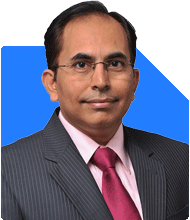Ramalingam Kalirajan |10017 Answers |Ask -Follow
Mutual Funds, Financial Planning Expert - Answered on May 14, 2024
He has an MBA in finance from the University of Madras and is a certified financial planner.
He is the director and chief financial planner at Holistic Investment, a Chennai-based firm that offers financial planning and wealth management advice.... more

Hi Team, I am 35 and have below SIPs. Please review them and let me know if i have to make any changes. Parag Pareikg flexi cap fund - 10000 Motilal Oswal S&P 500 index fund - 2500 Quant Small Cap Fund- 5000 PGIM India Mid Cap Opportunities Fund- 5000 SBI Banking & Financial Services Fund- 2500. Focus is to continue SIP for longterm
Evaluating Your SIPs
Your portfolio consists of a mix of equity funds focusing on different market segments. Here's a brief overview of each fund:
Parag Parikh Flexi Cap Fund (Rs. 10,000): Known for its flexible investment approach across market caps and sectors, providing diversification and potential for long-term growth.
Motilal Oswal S&P 500 Index Fund (Rs. 2,500): Provides exposure to the top 500 companies in the US stock market, offering diversification and growth potential in the world's largest economy.
Quant Small Cap Fund (Rs. 5,000): Invests in small-cap companies with high growth potential, suitable for investors with a higher risk tolerance and longer investment horizon.
PGIM India Mid Cap Opportunities Fund (Rs. 5,000): Focuses on mid-cap companies with strong growth prospects, offering potential for capital appreciation over the long term.
SBI Banking & Financial Services Fund (Rs. 2,500): Invests in companies operating in the banking and financial services sector, benefiting from the growth potential of the Indian financial industry.
Recommendations for Optimization
Your portfolio is well-diversified across different market segments, which is essential for long-term growth. However, here are a few suggestions to consider for further optimization:
Monitor Performance: Regularly review the performance of each fund and assess whether they continue to meet your investment objectives. Consider replacing underperforming funds or reallocating assets based on changing market conditions and your financial goals.
Assess Risk Tolerance: Ensure that your portfolio's risk level aligns with your risk tolerance and investment horizon. While small-cap and mid-cap funds offer higher growth potential, they also come with increased volatility. Make sure you're comfortable with the level of risk in your portfolio.
Consider International Diversification: While the Motilal Oswal S&P 500 Index Fund provides exposure to the US stock market, you may consider adding more international diversification to your portfolio. Explore options such as global equity funds or international index funds to broaden your investment horizon.
Review Sectoral Exposure: Given your investment in the SBI Banking & Financial Services Fund, be mindful of overexposure to a single sector. Monitor the fund's performance and consider diversifying across sectors to reduce concentration risk.
Conclusion
Overall, your SIP portfolio is well-structured and positioned for long-term growth. By regularly reviewing and optimizing your investments, you can maximize returns and achieve your financial goals with confidence.
Best Regards,
K. Ramalingam, MBA, CFP,
Chief Financial Planner,
www.holisticinvestment.in
You may like to see similar questions and answers below
Ramalingam Kalirajan |10017 Answers |Ask -Follow
Mutual Funds, Financial Planning Expert - Answered on Apr 08, 2024
Ramalingam Kalirajan |10017 Answers |Ask -Follow
Mutual Funds, Financial Planning Expert - Answered on May 14, 2024
Ramalingam Kalirajan |10017 Answers |Ask -Follow
Mutual Funds, Financial Planning Expert - Answered on May 06, 2024
Ramalingam Kalirajan |10017 Answers |Ask -Follow
Mutual Funds, Financial Planning Expert - Answered on May 25, 2024
Ramalingam Kalirajan |10017 Answers |Ask -Follow
Mutual Funds, Financial Planning Expert - Answered on Dec 28, 2024
Janak Patel |63 Answers |Ask -Follow
MF, PF Expert - Answered on Jul 31, 2025
Nayagam P P |9745 Answers |Ask -Follow
Career Counsellor - Answered on Jul 31, 2025
Radheshyam Zanwar |6014 Answers |Ask -Follow
MHT-CET, IIT-JEE, NEET-UG Expert - Answered on Jul 31, 2025
Nayagam P P |9745 Answers |Ask -Follow
Career Counsellor - Answered on Jul 31, 2025
Samraat Jadhav |2407 Answers |Ask -Follow
Stock Market Expert - Answered on Jul 31, 2025
Samraat Jadhav |2407 Answers |Ask -Follow
Stock Market Expert - Answered on Jul 31, 2025
Radheshyam Zanwar |6014 Answers |Ask -Follow
MHT-CET, IIT-JEE, NEET-UG Expert - Answered on Jul 31, 2025

Both are good options. Considering the opportunities in the tech field and the manpower demand, it is advisable to pursue AI+ML @ BIT Mesra for careers focused on software and AI.
Good luck.
Follow me if you receive this reply..
Radheshyam
Radheshyam Zanwar |6014 Answers |Ask -Follow
MHT-CET, IIT-JEE, NEET-UG Expert - Answered on Jul 31, 2025
Radheshyam Zanwar |6014 Answers |Ask -Follow
MHT-CET, IIT-JEE, NEET-UG Expert - Answered on Jul 31, 2025
Radheshyam Zanwar |6014 Answers |Ask -Follow
MHT-CET, IIT-JEE, NEET-UG Expert - Answered on Jul 31, 2025





















